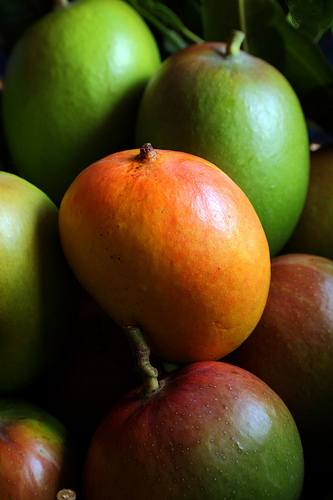Mango is one of the country’s high value crops but farmers do not have any standard procedure for identifying different varieties of mango at the early stage. Other than using the variety of the ‘mother’ tree as reference, mango growers have no reliable indices to identify type at the seedling stage. Farmers usually find out only later that the mangoes they nurtured are not what they desire.

To address these concerns, the Institute of Plant Breeding and the Department of Horticulture of the University of the Philippines at Los Baños, developed practical methods for identifying the different varieties found in the Philippines. The mango varieties are Carabao, Katchamita or Indian, Pahutan and Pico.
A farmer can either employ observation of physical characteristics or perform chemical tests to determine variety. Examination of the physical traits such as the leaves’ scent, shape and size will help in identifying the different mango varieties. The aroma of squeezed mango leaves is similar to that of its fruit. Carabao mango leaves smells like that of its fruit. This is also true for Pico and Katchamita, with Katchamita as the most aromatic of the three varieties. The leaf of a Pahutan mango, on the other hand, smells like a Pili nut.
Mature leaves, which are about three months old, also show distinctive traits for each variety. The leaves of Carabao, Pahutan and Pico mangoes are narrowly trullate while Katchamita leaves are narrowly rhombic. The mature leaves of Carabao are the largest among the mango varieties. They are also the only ones with an abrupt acuminate leaf tip. The leaves of Katchamita are relatively narrowest while Pico has the longest leaves.
The colors of week-old leaves of different mango varieties are constant and distinctive. Carabao has light green with a tinge of brown leaves and relative upright leaves while Pahutan has light green leaves. Katchamita has brown to brownish violet flushes while Pico leaves are light brown to light purple.
However, distinguishing leaf size and shape is not the most reliable way of determining variety since soil fertility and other environmental factors affect these traits. Carabao mango may not have large leaves if the soil is not fertile. Using the shape of the leaf tip in finding out variety is only applicable to the Carabao type as the three other varieties have similar leaf tips. A mango farmer can also do simple chemical tests using acidic methanol solution or acidified vanillin. Soaking the young mango leaves, about 19 days old, in soap solution is the first step. The next step indicates rinsing the leaves and allowing them to dry on paper. After collecting a gram of treated leaves, cut the leaves into small pieces and pound using mortar and pestle while adding acidified methanol. Filter the extract using Whatman #2 filter paper until the volume reaches 10 ml. The color of the extract will determine the variety of the mango. The Pahutan extract has the most intense green color followed by the Carabao variety. Pico and Katchamita have a similar yellowish green color.
Another test requires the use of acidified vanillin as a reagent. This method calls for a mixture of three ml of 4% vanillin in methanol and 1.5 ml concentrated hydrochloride. Use a swirl to mix the solution on a petri dish. Dip five strips (1 inch by 2 inches) of filter paper in the acidified vanillin solution for 30 minutes. The treated vanillin paper will determine the variety by placing a drop from the juice of the pounded leaves. After 15 minutes, the juice will result in a color reaction with the paper. The reaction from the Carabao variety is light pink, pink for Katchamita and Pico, and light green for Pahutan.
——————————-
Source:
Paper presented during the 13th National Research Symposium entitled, “Indices for varietal identification of mango” by Evelyn Mae Tecson-Mendoza, Felicito Rodriguez, Perla Baldiviano and Leon Namuco.
By: Ma. Rowena S.A. Briones, BAR Chronicle, November 2001 Issue (Vol. 2 No. 21-22)

Hello
Great extra tip and thank you for sharing
I haven’t used collection to their potential yet but will look to check it out more closely.